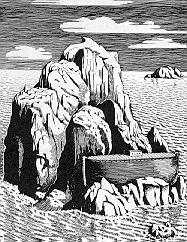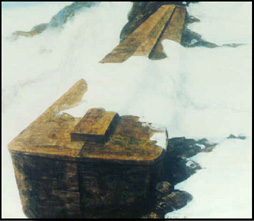We could show them topsy turvy fossils all day long, it won't matter to the one who refuses to believe.
It's like a God hater who specifically asks, "Show me Potato Salad".
It's like a Muslim asking the foolish question, "Where in the Bible does Jesus say, 'I am God worship me.'"
You show them where Jesus is claiming to be God, and receives worship. They turn around and say, "No, the specific words."
When its make up the rules as you go for them, and we play by that rule, we lose.
They even have to deny all of the historical quotations that are direct, mention direct and also the indirect witnesses of Noah's ark upon the Mts of Ararat -
"...
257 BC Berosus, Caldean historian
"But of this ship that grounded in Armenia, some part if it still remains ... and some get pitch from the ship by scraping it off and use it for amulets to ward off evil." (p. 15).
1st C Jewish historian Flavius Josephus mentions the remains of Noah's ark 3 times.
"The Armenians call that spot the Landing-Place, for it was there that the Ark came safe to land, and they show the relics of it to this day. This flood and the Ark are mentioned by all who have written histories of the barbarians. Among these is Berosus the Chaldean, who in his description of the events of the flood writes somewhere as follows: 'It is said, moreover, that a portion of the vessel still survives in Armenia on the mountains of the Gordyaens, and that persons carry off pieces of bitumen, which they use as talismans.' These matters are also mentioned by Hieronymus the Egyptian, author of the ancient history of Phoenicia, by Mnaseas and by many others. Nicholas of Damascus in his ninety-sixth book relates the story as follows: 'There is above the country of the Minyas in Armenia a great mountain called Baris, where, as the story goes, many refugees found safety at the time of the flood, and one man, transported upon an ark, grounded upon the summit: and relics of the timber were for long preserved.'
"... the country called Carrae: it was a soil that bare amomum in great plenty: there are also in it the remains of that ark, wherein it is related that Noah escaped the deluge, and where they are still shown to such as are desirous to see them" (pp. 16-17).
180 AD Theophilus of Antioch
"And of the Ark, the remains are to this day to be seen in the Arabian mountains" (p. 17)
4th C Bishop Epiphanius of Salamis
"Do you seriously suppose that we are unable to prove our point, when even to this day the remains of Noah's Ark are shown in the country of the Kurds? Why, were one to search diligently, doubtless one would also find at the foot of the mountain the remnants of the altar where Noah, on leaving the Ark, tarried to offer clean and fatly animals as a sacrifice to the Lord God" (p.21).
4th C John Chrysostom
Do not the mountains of Armenia testify to it, where the Ark rested? And are not the remains of the Ark preserved there to this very day for our admonition" (p. 21).
610 BC Isidore of Seville
Ararat is a mountain in Armenia, where the historians testify that the Ark came to rest after the Flood. So even to this day wood remains of it are to be seen there" (p. 22)
1245 AD Jehan Haithon, a monk
"Upon the snows of Ararat a black speck is visible at all times: this is Noah's Ark" (p. 21)
1633 AD Adam Olearius
"The Armenians, and the Persians themselves, are of opinion that there are still upon the said mountain some remainders of the Ark, but that Time hath so hardened them, that they seem absolutely petrify'd. At Schamachy in Media Persia, we were shown a Crosse of a black and hard Wood, which the Inhabitants affirmed to have been made of the Wood of the Ark" (p. 22).
1856 AD Haji Yearam
"It was an unusually hot summer, so the snow and glaciers had melted more than usual. The Armenians were very reticent to undertake any expedition to the Ark because they feared God's displeasure, but the father of Haji thought that possibly the time had come when God wanted the world to know the Ark was still there and he wanted to prove to those atheists that the Bible story of the Flood and the Ark is true.
"They went inside the Ark and did considerable exploring. It was divided up into many floors and stages and compartments and had bars like animal cages off today. The whole structure was covered with a varnish or lacquer that was very thick and strong, both outside and inside the ship. The ship was built more like a great and mighty house on the hull of a ship, but without any windows. There was a great doorway of immense size, but the door was missing. The scientists were appalled and dumbfounded and went into a Satanic rage at finding what they hoped to prove nonexistent. They were so angry and mad that they said they would destroy the ship, but the wood was more like stone than any wood we have now. They did not have tools or means to wreck so mighty a ship and had to give up. They did tear out some timbers and tried to burn the wood, but it was so hard it was almost impossible to burn it.
"They held a council, and then took a solemn and fearful death oath. Any man present who would ever breathe a word about what they had found would be tortured and murdered"
(pp. 46-47).
In 1915, just before Haji died at 75 years old, he told his story. In 1918 on his death bed one of the 3 atheists told his story which matched in every detail.
1883 AD Turkish scientists, soldiers, and a British diplomat, Captain Gascoyne, investigated an earthquake on Ararat.
"At last they were rewarded by the sight of a huge dark mass, protruding twenty or thirty feet from the glacier, on the left side of the ravine. ... It was in a good state of preservation, being painted on the outside with a dark brown pigment, and constructed of great strength. ... the explorers found it filled for the greater part with ice, the interior being partitioned off into compartments about twelve or fifteen feet high..." (p. 57).
1908-10 Georgie Hagopian, Armenian immigrant
"The Ark was resting on a huge rock, bluish-green in color, but one side was on the edge of a steep cliff. The mountain was impossible to climb from the side. When he looked over the edge, he could hardly see the bottom of the mist.
"The Ark was very long and rectangular. Parts of the bottom were exposed and he could see that it was flat. The roof was nearly flat, except for a row of windows, 50 or more, estimated size 18 inches x 30 inches, running from front to back covered by an overhanging roof. The front was also flat. The side tipped out a little from the bottom to top.
"The wood appeared to be entirely petrified" (pp. 70-71).
1916-17 Russian and Turkish soldiers entered the Ark.
1943 American Airmen photographed the Ark.
1948 Kurdish Farmer named Resit
"The prow of a ship protruding into a canyon waas seen. The prow was almost entirely revealed, but the rest of the object still was covered." (p.115)
1



